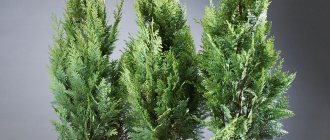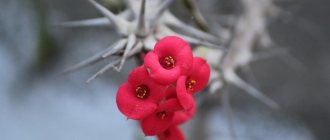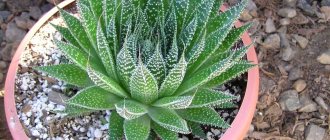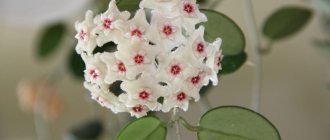A beautiful indoor Radermacher tree, a photo of which can be seen below, is very popular among domestic flower growers.
This culture does well at home.
Radermachera is easy to care for and has lush glossy foliage, which allows the flower to fit perfectly into any room interior.
general information
Radermachera (lat. Radermachera) got its name in honor of the Dutch scientist who found it in the forests of Southeast Asia. It belongs to the Bignoniaceae family and has 16 species in the genus. In the natural environment it lives up to 20–30 years, but even at home it can delight the owner for decades.
Expert opinion
Mokhov Andrey Petrovich
Graduated from KubSAU, specialty: agronomy
Chinese Radermachera (Radermachera sinica) is the only representative of the genus among indoor plants.
You can buy Radermachera online or at a flower shop. The price depends on the size and starts from 500 rubles for a tree 20–25 cm high. A plant about a meter in height will cost about 2,500 rubles.
The china tree is similar in appearance to ash, ficus, hibiscus, laurel and coffee tree.
The snake tree, despite its name, is not poisonous. Moreover, it perfectly purifies the air.
Origin and description of appearance
Radermacher first appeared in Europe only in 1980, although the Dutch botanist Radermacher described the genus back in the 18th century. The plant got its name in honor of the scientist.
The plant belongs to the Bignonieceae family, a genus of evergreen ornamental deciduous shrubs and trees.
Radermachera is distributed in the territories of Southeast Asia and in the mountainous regions of China, where a subtropical climate prevails. Grows in open sunny meadows and mountain slopes. Under natural conditions it can reach 20–30 m, and at home the maximum height is 1.5 m.
In its homeland, Radermacher is grown as an outdoor plant.
Radermachera has spreading, not too branching shoots. The leaf is complex, large, reaches 30 cm in length. It is located on a long petiole. It consists of opposite triply pinnate leaves of an elongated ovate shape. The leaf blade is slightly wavy and has a pointed end. These amazing emerald green glossy leaves are the main decoration of the Radermachera. They create an openwork and lush, translucent crown, for which the plant is loved by many gardeners.
The plant does not bloom in apartment conditions, although there are happy exceptions
Radermachera blooms only in natural conditions. The flowers look like large bells and are white, grayish-yellow or yellow-orange in color. They bloom only at night and exude a delicate aroma of cloves.
Blooming Radermachers - photo gallery
This is how Radermachera sinensis (or blueberry) blooms
Beautiful Radermachera cuming flowers
Radermachera fiery blooms with orange bells
The beautiful Radermacher plant is a picky plant; it adapts perfectly to apartment conditions. Even a beginner can choose the right place for cultivation and comply with the minimum care requirements. The only problem may be the size of the plant itself, which grows very quickly.
Radermachera Caprim belongs to the variegated species
There are about 15 plant species in nature. Among them there are also variegated forms, for example, Radermachera Caprim. But in home floriculture, only one is successfully grown - Radermacher Sinica (or Chinese).
Photo gallery
It has a main trunk and several horizontal shoots that become woody over time. Their surface is smooth and covered with gray-green bark.
A distinctive feature of Radermachera are the “lentils” - small oval thickenings on the branches.
Long oval or ovoid leaves grow close to each other. They are glossy with jagged edges. Initially they have a light green color, but over time they darken from the middle.
The emerald tree almost never blooms indoors. The first buds on it can be seen only after 10–15 years. In the wild, they appear in the summer directly on the trunk or in the axils of the leaves and are very similar to bells. The color is white, cream or yellow-orange.
Expert opinion
Mokhov Andrey Petrovich
Graduated from KubSAU, specialty: agronomy
The flowers open only at night and emit the scent of cloves, cinnamon or jasmine.
Radermachera species
The Radermachera family includes 17 studied species. Most of which are completely unsuitable for living at home due to their large size.
Radermachera sinensis grows well at home ; it will be written about further below. This is a beautiful shrub from 1 to 2 meters in height with a beautiful spreading crown. The leaves are long, 40-50 cm long and 15-20 cm wide. Leaves with jagged edges are dark green.
Radermachera Kunming is a small tree, about 40-60 centimeters, only when it reaches this size does the plant begin to bloom. You can only find them in Thailand; in all other places there are only private collections.
Radermacher Eugenia, better known as jasmine tree, is common in northern Laos, Thailand, Hainan Island and Burma. A plant with orange flowers, reaches a length of 20 meters.
Radermacher Rami flora grows in the tropical forests of Borneo. The tree reaches a length of up to 30 meters, a narrow trunk no more than 30 centimeters in diameter. Plant with fruits, gray leaves, yellow flowers.
Radermachera arboreal is an annual plant growing in Indian forests, where drought is most common. The crown during the flowering period is distinguished by its beauty. On the crown of the trees, among the bright green leaves, the length of which is about 100 centimeters, there are small inflorescences. The inflorescences of this plant are similar to those of gladioli (small funnel).
All types of Radermachera are very fond of the sun, good lighting (at home), warmth, optimal temperature 20 - 25 C and moisture, with the exception of those species that grow in dry places.
Signs and superstitions
Radermacher absorbs negative energy and helps you focus on important things. It is believed that the tree activates the spiritual chakras and opens channels of communication with a higher power, therefore it is suitable for people engaged in spiritual practices.
Is your Radermacher growing?
If a plant dies unexpectedly, it is believed that it has warded off a strong evil eye from its owner. According to Feng Shui, indoor ash has a beneficial effect on the atmosphere of the home. It is also a symbol of education.
Radermacher cannot tolerate tobacco smoke.
How to form a radermachera in bonsai style
- Plant it in a small container (take not very fertile soil).
- Apply fertilizers rarely and in minimal quantities.
- When replanting, trim the roots.
- Remove excess side shoots, buds and twigs.
- Twist, bend and weight the branches using weights and wire until they become woody.
- Turn the plant with different sides towards the light so that the crown is formed evenly.
- Cut the bark to age the tree.
Carry out all procedures for forming a tree in the spring and summer and only after it has strengthened in the pot.
Pruning of branches and roots should be aimed at balancing the proportions of the bonsai above and below ground.
Chinese radermachera
This type of plant is distinguished by its dense vegetation and looks like a small shrub. A distinctive feature of this species is its highly curly shoots, which must be periodically pruned. Otherwise, the bush may begin to shed its lower leaves. The size of the leaves reaches 40 cm in length. In the natural environment, this flower can bloom, the aroma from flowering resembles the smell of carnation blossoms.
Home care
Caring for an emerald tree does not require a lot of time and effort. The main thing is good lighting and proper care, which has seasonal characteristics.
| Season | Temperature | Humidity | Lighting |
| Spring | 20–22˚С, no drafts, diffused light. | Increased | Bright diffused light. Avoid direct sunlight. |
| Summer | |||
| Autumn | Not lower than 10–13˚С. Optimally 16–18˚С. No drafts. | Adapts to dry air | The brightest place. You need to use phytolamps. |
| Winter |
Winter is the tree's dormant period.
Radermachera grows best in moderate humidity to provide it with the right conditions:
- place the pot in a tray with damp expanded clay, sphagnum or pebbles;
- spray leaves in hot weather;
- Once every 10 days, give the plant a cool shower (cover the ground with polyethylene).
Expert opinion
Mokhov Andrey Petrovich
Graduated from KubSAU, specialty: agronomy
When immersing the pot in expanded clay, moss or pebbles, make sure that the bottom does not touch the water.
The plant loves bright, diffused light. Therefore, place it on southwest or southeast windows. In this case, the leaves should not touch the glass. When placing the tree in the south, make sure that direct sunlight does not fall on it.
Radermachera care: what to consider
If you know how to care for radermachera, then growing it will be a real pleasure. The plant is completely unpretentious. But at the same time it is very grateful and capable of growing at a gigantic pace to the delight of the gardener.
Recommendations from flower growers on how to care for radermachera after purchase say that you can start with a transplant. But it is best to give the plant a couple of weeks to acclimatize, and only then start changing the pot.
An ornamental tree, accustomed to growing in mountainous areas with clean fresh air, absolutely cannot tolerate unpleasant odors. It will die if exposed to burning or tobacco. You should not place the flower near the smoking room or in the kitchen.
Lighting
The unpretentious Asian woman is a big lover of light. But she prefers only diffused lighting and does not tolerate direct sunlight at all. For Radermachera, exposure to bright sun and lack of light is dangerous. Florists recommend creating the following conditions.
- Optimal place. An indoor flower will feel comfortable on a western or eastern window.
- Arrangement of the place. You can place an emerald tree on a northern windowsill, provided that sunlight reaches it. If the choice is on the southern window sill, then you need to shade the window with a matte curtain or film.
- All-round light. The best place for a radermachera will be a glazed loggia or bay window, providing lighting from all sides. In this case, the tree will grow proportionally.
- Constant turning. If it is not possible to ensure a uniform supply of light, then you must remember to periodically rotate the plant. This way all branches will be equally developed.
In winter, the plant may not have enough light. In this case, the Radermachera's internodes will begin to stretch out. The tree will lose its compactness and begin to resemble a vine. Therefore, in winter it is necessary to supplement the lighting with a phytolamp.
Temperature
Growing Radermachera at home does not require special conditions. The indoor tree willingly adapts to natural temperature changes. It is not necessary to provide it with a decrease in temperature in winter, since Radermachera does not bloom. To create comfort for the plant, use these recommendations.
- In summer. Emerald wood loves warmth. It can easily withstand up to +28°C. The tree can tolerate even extreme heat. But in such conditions it is necessary to increase the air humidity.
- In winter. The plant does not need cool conditions. But at the same time it can withstand temperature drops down to +11°C. Experienced flower growers advise providing the Radermacher with winter rest. After hibernation, the tree grows more actively and suffers less.
Humidity
The Asian guest loves moderately humid air. In conditions of sufficient humidity, it can withstand the heat and put up with the proximity of heating devices. However, you should not overdo it with moisturizing. Otherwise, the radermacher will simply rot, starting from the root. Provide the plant with simple conditions.
- Normal humidity. Increase the moisture content in the air using different methods. You can resort to a tray with moistened expanded clay, moss or peat, or simply place containers with water.
- Spraying. Regular spraying of the crown with a spray bottle helps combat low humidity.
- Bathing. Radermacher will happily “take a shower,” especially when the heating is on. But during the procedure, it is recommended to cover the soil with film so as not to flood the root system. Bathing will clean the plant from dust and dirt.
In winter, after swimming, do not rush to take the tree out of the bathroom. Give the Radermacher a chance to dry a little in the warmth. And after three to five hours, when the droplets have completely dried on the leaves, you can put the pot back in place.
Watering
Radermachera needs abundant and regular watering. At the same time, it is important to remember a sense of proportion. The plant is not suitable for periodic watering or heavy flooding “for later”. The tree needs a regular supply of moisture in small quantities.
- Watering frequency. At normal temperatures, in spring and summer, the soil must be moistened three times a week. It is important not to let it dry out. If the temperature rises above 26°C, then the Radermacher needs to be watered more often.
- Soft water. Only settled water is suitable for emerald wood. You can use rainwater. Chlorinated water supply is strictly contraindicated.
If the soil accidentally dries out, do not over-moisten the soil. By flooding the plant, you will cause the roots to rot. It is necessary to restore normal watering after a short drought gradually.
Trimming
Radermacher grows very quickly. Therefore, it is necessary to constantly curb the excessive pace of development. To do this, long shoots are periodically pruned. It is optimal to prune in the spring.
The top of young Radermachera must be pinched. This procedure will provide greater branching to the plant.
Top dressing
The rapidly growing Radermacher needs feeding. Fertilizers begin to be applied in March, when the active growing season begins. When choosing and applying fertilizing, it is recommended to adhere to these rules.
- The right fertilizers. The emerald tree is suitable for mineral fertilizers intended for decorative deciduous crops. If Radermachera has variegated foliage, then the nitrogen content in the fertilizing should be minimal, otherwise the tree will lose its variegated “zest”.
- Frequency of fertilizing. Fertilizers must be applied every 15-20 days. This is enough to ensure effective growth and full development.
- Application method. To properly feed the crop, you need to dilute the fertilizer according to the instructions and apply it to the soil after watering with regular water.
After September, it is recommended to stop feeding so that the plant can rest. The fertilization process is resumed next year in March.
Transfer
It is recommended to replant young plants annually. When the Radermacher turns three years old, this process will become significantly more complicated, because the tree will become large. Therefore, adult specimens are replanted only when necessary, approximately once every two to three years.
The most suitable time for transplantation is spring, the first days of March. Therefore, even a plant purchased in the fall is best left until spring. But if the root system grows through the drainage, then after two weeks of acclimatization it is necessary to transplant the radermacher into another pot. The transplant is carried out according to the following rules.
- Choosing a pot. The new pot should be only 2-3 cm larger than the previous one. Radermacher has an underdeveloped fibrous system, so large flowerpots are completely unsuitable for her. If you plant a tree in a very spacious pot, then instead of growing a crown, the emerald tree will begin to develop roots.
- Soil preparation. The plant needs loose soil, which will ensure normal air circulation and sufficient water outflow. For replanting, it is recommended to prepare a substrate by mixing one portion of sand, two parts each of peat and turf soil and four portions of leaf soil. You can take ready-made soil: a universal one or a substrate for decorative deciduous crops.
- Drainage system. To ensure normal outflow of water and prevent moisture from stagnating in the soil, coarse drainage is poured to the bottom, approximately 3 cm.
- Radermachera transplant. The plant is carefully removed from the old flowerpot. To check the condition of the roots, carefully loosen the soil with a wooden stick. Do not separate the old soil with your hands and do not soak the rhizome in water. The emerald tree will not withstand such events. And the reviews confirm this. Transplantation is carried out according to the principle of transshipment, moving the roots with the old soil into a new flowerpot and sprinkling them with the prepared substrate.
Pruning and crown formation
Radermachera grows quickly, so it needs regular pruning and pinching of shoots. The procedures are carried out in mid-April. At this time, the longest branches are cut by 1/3, and thin and elongated shoots are removed. If you additionally remove the side branches, exposing the main trunk, the plant will take on the shape of a tree.
If you regularly pinch the upper buds, it will look like a lush bush. There is another way of pruning - to a stump. This is a drastic measure, but the plant tolerates it well and soon produces new shoots.
general description
The homeland of the plant in question is considered to be the southeastern part of Asia. The flowers belong to the begoniaceae family. There are 16 varieties of such crops in the world, but only Radermachera sinensis can develop in indoor conditions. Under natural conditions in its homeland, this plant takes on the appearance of an evergreen tree. Under favorable conditions, its height can reach 30 meters.
The plant was first described in the 18th century by the Danish scientist Jacob Radermacher.
Priming
Indoor ash needs loose, fertile soil. You can prepare it yourself: mix turf and leaf soil, peat and humus in a ratio of 1:2:1:1. Add a handful of coarse sand, agroperlite, vermiculite or crushed pine bark.
Expert opinion
Mokhov Andrey Petrovich
Graduated from KubSAU, specialty: agronomy
Before planting the plant in a homemade substrate, disinfect it by heating or freezing.
But it is better to use ready-made soil for decorative foliage plants (roses, citrus fruits or palm trees). Indeed, in this case, the quality of the mixture will be much higher, and the risk of infecting the plant from the soil is minimal.
Radermachera can grow on a nutrient solution.
Recommendations for planting and replanting Radermachera
Nutritious and loose soil that can freely pass air and water is most preferable for Radermachera. If the choice is made in favor of ready-made store-bought soil, you can purchase soil mixtures intended for roses, palm trees or citrus fruits. It is also easy to prepare the substrate yourself; to do this you will need to mix:
- humus - 1 part;
- sand (river, coarse fraction) – 1 part;
- leaf soil - 2 parts;
- turf soil - 1 part;
- pine bark - 1 handful.
When choosing a pot, keep in mind that Radermachera prefers close quarters. Therefore, it is not recommended to plant it in containers that are too large.
The pot size should be increased gradually during replanting. Each subsequent one should be only a couple of centimeters larger than the previous one.
The ideal pot for Radermachera is wide enough, round, not too tall
It is important to ensure that the pot has drainage holes. They allow excess moisture to be removed from the soil. In addition, it is necessary to make a drainage layer about three centimeters thick. For it you can use:
- expanded clay;
- broken brick;
- crushed foam.
If the plant is young, it is recommended to replant it annually in the spring; an adult specimen will not require such frequent replantings. It is enough to carry out the procedure once every two to three years. It is advisable to replant Radermachera purchased in a store within seven days.
Radermacher should be replanted when the roots are completely entangled in the earthen ball.
The day before transplanting, Radermacher should be watered generously. The procedure is carried out using the transshipment method, which preserves the earthen lump.
When transplanting Radermachera, it is useful to trim the roots that protrude beyond the earthen ball by about two millimeters. This increases their ability to absorb.
Transfer
Transplantation is carried out in the spring. Young plants undergo this procedure annually, adults - once every 2-3 years. You can determine that the Radermacher plant needs a new pot by its roots: they will entwine the entire container and will be visible from the drainage hole.
The plant must also be replanted 2–3 weeks after purchase. He needs this time to acclimatize in the apartment.
- Prepare the pot in advance: rinse the old one well or soak the new one in water for several hours.
- Stir the soil 2 hours before planting to saturate it with oxygen.
- Water the plant generously the previous day.
- Place 3 cm of expanded clay drainage at the bottom of the pot.
- Lay out a small layer of soil.
- Remove the radermachera from the old pot along with the soil.
- Remove old and damaged roots; in adult plants, cut them by 1/3.
- Treat the cuts with a fungicide or crushed charcoal.
- Transfer the tree along with a lump of earth into a new pot.
- Add new soil.
- Water it.
After transplanting, place the pot in partial shade. The plant will look lethargic for the first few days, but will recover later. After that, move it to its usual place.
How does a flower reproduce?
Radermachera propagates through air layering, cuttings and seeds.
Cuttings
Radermacher cuttings are cut in late spring or early summer from plants at least 3 years old. The flower must be healthy, without the slightest trace of damage by insects. The cutting is the upper part of the shoot, 8–12 cm long. It is desirable to have at least 2 internodes on it.
- The cut areas on the “donor” plant and cuttings are treated with a 1–1.5% fungicide solution and sprinkled with “powder” of activated carbon or chalk. The cuttings are allowed to dry for 3–4 hours.
- Shallow containers are filled with a mixture of peat chips and sand, perlite, vermiculite (1:1). The substrate is well moistened and leveled. An alternative method is rooting in water or a solution of a root formation stimulator.
- Cuttings cut down are inserted into the substrate to a depth of 1.5–2 cm or lowered into water so that it does not touch the bottom. Interfering leaves are removed. The plantings are covered with glass jars or the bottoms of plastic bottles, creating a “greenhouse effect.”
- The cuttings are ventilated daily for 5–7 minutes, and the soil is sprayed with a weak solution of a root formation stimulator as it dries. Bright light and a constant temperature of 24–26ºС are important.
- Rooting takes 1.5–2 months. Then the radermachers are planted in separate pots with substrate for adult plants. The care is normal.
For Radermachera cuttings, it is important to create greenhouse conditions for rapid rooting.
Germination of seeds
At home, Radermachera practically does not bloom, but the seeds are sometimes found for sale in specialized stores. They are quite small and have a small “wing”.
- Buy a special fortified peat-based soil with the addition of fine sand, fill small containers with it, and moisten the substrate well.
- Plant 2-3 seeds in each “pot”, burying them slightly into the soil. Cover the container with glass or film on top, creating a “greenhouse”.
- Always keep the substrate slightly moist, provide bottom heating and a constant temperature of 22–25ºС. Ventilate the plantings every 2-3 days.
- The first shoots will appear in 7–10 days. Sprouts with 2–3 leaves (after 3–3.5 weeks) are transplanted into individual containers with the same soil. When spring comes, the grown flower is replanted again and then cared for as usual.
Radermachera seeds germinate amicably and quite quickly
Rooting air layering
A layer is essentially the same cutting, but the process of root emergence in this case can be observed with your own eyes. Only specimens with already developed roots are planted. The method is only suitable for mature plants with a woody trunk.
- A shallow (1–1.5 mm) circular cut is made on the trunk or one of the old shoots, wrapped in strips of wet moss or coconut fiber, and on top with polyethylene, securely and hermetically fixing the entire structure.
- Once every 2–3 days, the polyethylene is removed and the material underneath is sprayed. The plant on which the incision is made is kept under normal conditions.
- When the roots growing from the cut reach a length of 3–5 cm, the stem is separated and a new plant is transplanted into a mixture of peat and humus. The approximate diameter of the pot is 12–15 cm. Do not rush to cut off the cuttings as soon as the roots appear. A poorly developed root system is not able to provide nutrition to the voluminous green mass.
- This coming spring, the radermacher is replanted again and cared for like an adult plant.
The method is only suitable for mature plants with a woody trunk.
Reproduction. Table
The emerald tree reproduces vegetatively or generatively . The first method is mainly used because the seeds are almost impossible to obtain on your own. However, they are found in some flower shops.
| Seeds | By layering | Cuttings |
| 1. Distribute the seeds over the soil. 2. Spray. 3. Cover with film or glass. 4. Leave in a warm place for 10–15 days. 5. After germination, remove the covering. 6. After 15–20 days, transplant the sprouts into separate containers. | 1. Make a cut on the trunk. 2. Apply wet sphagnum moss. 3. Wrap in plastic. 4. Ventilate the incision site daily. 5. Spray the moss. 6. Replant the branch after its roots cover the entire surface of the film. | 1. In May or June, cut off the shoot at a height of 8–10 cm. 2. Choose a shoot with at least one leaf and an internode. 3. Plant the cuttings in a damp mixture of peat and sand. 4. Set up a mini-greenhouse. 5. Ventilate and moisten once a day. |
Expert opinion
Mokhov Andrey Petrovich
Graduated from KubSAU, specialty: agronomy
In the place where the seedlings are located, maintain a temperature of 20˚C.
Difficulties in growing
Among the most common problems faced by gardeners are:
- Radermacher leaves turn yellow and fall off - this indicates that the plant is experiencing a lack of sunlight. To restore the flower, it is necessary to move it to another place where there will be more light, because the emerald tree is not a shade-loving plant;
- the color of the leaves changes, and later they wither - the plant does not have enough moisture, therefore, it is necessary to increase the frequency of watering. However, with excess moisture, the leaves can lighten and at the same time become depleted;
- the gap between the leaves becomes large, and the leaves become smaller and paler - there are not enough nutrients in the soil or its composition was incorrectly chosen during the replanting process. Very often this problem can occur with a lack of sunlight;
- the crown of the tree stretches out, and the trunk becomes thinner - this happens if the conditions for keeping the plant in winter, when it rests, are not observed correctly. It is placed in a bright but cool room.
In addition, flower growers very often ask why the tips of the leaves of the Radermacher flower dry out and what to do about it? This phenomenon may also be accompanied by blackening of the leaf blade. The reason for this phenomenon may be low room temperature or direct rays hitting the plant.
Fertilizer and feeding
Feeding in the spring-summer period is carried out twice a month. With the onset of autumn it is gradually reduced to nothing. In winter, the plant is not fed. It is recommended to apply fertilizer only a few hours after watering, so as not to burn the roots.
From April to August, feed the Radermacher with a complex fertilizer for ornamental foliage plants, for example, Kemiroy Lux, Agricola, Etisso.
Do you use fertilizers or flower food?
Features of seasonal care
Spring and summer for Radermachera are a period of active growing season. In order for it to develop and grow well at this time, it needs to be provided with a temperature of +20..25°C, regular feeding, moderate watering and good lighting.
The culture does not have a clearly defined dormant period. But in winter, all processes slow down and the plant needs to be given the opportunity to rest. To do this, the flower is moved to cooler conditions (about +16°C). The number of waterings is reduced and fertilizing is not applied. But the lighting should be plentiful.
Problems with leaves. Table
| Signs | Causes | Solution |
| They fall off, and the shoots become thinner and longer | Little light | Move, use phytolamps to extend daylight hours. |
| Become small and dull | Lack of nutrition | Fertilize or replant. |
| Wither | Under or over watering | In the first case - water, in the second - replant. |
| The ends dry out | Low humidity | Spray or place in a tray with damp expanded clay. |
If you are going on vacation
There are two ways to save a tree while you are away. The first is to ask relatives or friends, the second is to purchase or design an automatic watering system. To enhance the effect:
- put all the plants in one place;
- create partial shade in the room;
- Water thoroughly;
- cover the pots with wet expanded clay;
- thin out the leaves.
Diseases and pests. Table
| Diseases and pests | Signs | Causes | Prevention and treatment |
| Root rot | Black spots on the stem from the base. At the same time, it becomes soft. | Waterlogging, low temperatures. | Replant in soil treated with a fungicide and remove damaged roots. |
| Spider mite | Cobwebs on the leaves, they curl and dry out. | Remove damaged leaves and treat with Aktara or Fufanon. | |
| Aphid | Deformation of shoots, there are green insects on the plant. | Wash the plant with a mild soap solution. Treat with Actellik. | |
| Mealybug | Sticky dirty white balls on leaves. | Carry out 3 treatment procedures with Aktara at weekly intervals. | |
| Shchitovka | The shoots turn yellow and become deformed, the leaves dry out. | Insufficient humidity and elevated temperature. | Wash the leaves with soapy water. Treat with Fitoverm and Actellik. |
Radermachera will complement any interior with its bright emerald glossy foliage. In addition, a neat tree looks very stylish. And since it feels great indoors, you don’t have to take special care of it.
Reviews from flower growers about growing Radermachera
A very nice plant. Although it does not bloom, it pleases the eye with its abundant greenery and aesthetic appearance. Will decorate any interior. It seemed to me quite unpretentious, but I can’t abandon it for a long time, since it really likes frequent spraying. It is clear that spraying it every day is a very tedious task, but at least once every two or three days. It grew quickly for me, so I had to constantly turn it in a circle so that one side did not stretch too much towards the light, but there was symmetry. In direct sunlight, the Radermacher does not feel very good; it needs bright but diffused light, so it is better not to place it on a windowsill, and also for the reason that drafts are contraindicated for it. I fertilized it with the same thing as all plants - phosphorus, nitrogen, during watering and through spraying. Professional florists promise that with proper care, the plant can grow up to 2 m, and when it reaches 15 years of age, it can even begin to bloom!
Trooke
https://otzyv.expert/prekrasnoe-rastenie-1893359
Previously, there was no place for plants in my life. Only cacti survived for me. With the move to a new apartment, I wanted comfort. Then I asked my boyfriend to give me an indoor flower. I don’t know on what basis he chose, but his choice fell on Radermacher. What can I say about him? Firstly, after reading the rules for caring for him, I was horrified. Don’t put it there, water it like that, replant it once every 3 months, etc... Horrible. Especially for me. But how can you help but look after a gift from a loved one))) It’s on my windowsill, on the sunny side of the apartment (actually, there are no others), but the sun is still removed due to the balcony. I water it once every 3 days. Every day I spray a little from a spray bottle. This is where my departure ends. I am incapable of more. But Rademacher is not complaining. It grows for its own pleasure and turns green. So I concluded for myself that all the advice on the Internet is exaggerated and this creature is not that picky.
KlavKaG
https://otzovik.com/review_3499239.html
From personal observations I concluded that Radermachera loves moisture very much. More precisely, it does not like dryness. Last year, it started to fall in leaf at the beginning of the heating season, now I simply spray it during hot (summer or heating) periods and it doesn’t fall anymore, well, it actually withers a little if a crowd of people rushes through the apartment and the persistent smell of tobacco smoke remains. She really doesn’t like tobacco smoke and is very afraid of drafts; the first sign of her dissatisfaction is “leaf falling.”
Melissa
https://iplants.ru/forum/index.php?showtopic=4730











